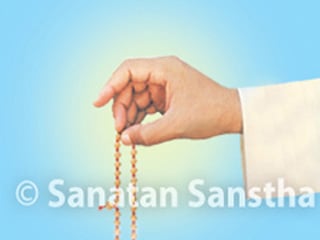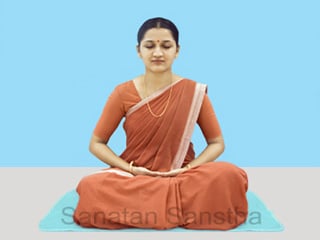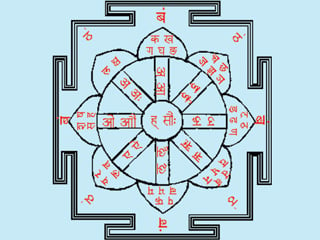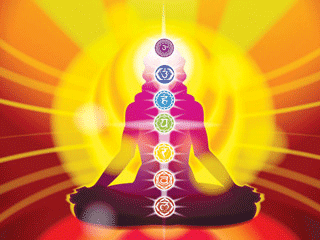Contents
- 1. Asans (postures), pranayam and chanting
- 2. Ritualistic worship (karmakand) and chanting
- 3. The sacrificial fire (yadnya) and the sacrificial fire of chanting The Lord’s Name (japayadnya)
- 4. Action (karma), chanting of The Lord’s Name and God
- 5. The results of action and chanting The Lord’s Name
- 6. Meditation and chanting
- 7. The thoughtless state and chanting
- 8. The method of stopping chanting of other Names
- 9. Path of Knowledge (Dnyanyoga), Path of Action (Karmayoga), Path of Devotion (Bhaktiyoga) and Path of Chanting The Lord’s Name (Namasankirtanyoga)
- 10. The spiritual level of a seeker, spiritual practice and some of its effects
- 11. Relative importance of various spiritual practices with and without chanting
- 12. The importance of various types of spiritual practice in seekers of 40% spiritual level with reference to generation of spiritual emotion
- 13. Path of Chanting The Lord’s Name (Namasankirtanyoga) and the Path of Guru’s Grace (Gurukrupayoga)
- 14. The stance of a spectator (sakshibhav) and chanting The Lord’s Name
- 15. Realising that ‘everything occurs due to God’s wish’ (Ishvarechcha) and chanting while working
- 16. The proportion of purification of various bodies with various paths of spiritual practice
- 17. A gross comparison of the stages of progress in the various paths of Yoga recommended by the Guru or followed with one’s own intellect
1. Asans (postures), pranayam and chanting
Asans and pranayam are spiritual practices to be performed by the physical body whereas chanting is to be performed by the subtle body. The spiritual practice of the subtle body cannot be performed well with the physical body but that of the physical body can be performed well with the subtle body. Hence, in comparison to pranayam and asans chanting is a superior spiritual practice.
2. Ritualistic worship (karmakand) and chanting
Is waking up at the auspicious time of the Brahmamuhurt, that is 3 a.m. and purifying oneself by bathing, taking a sattvik diet (rich in the sattva component), fasting, observing seclusion during menses, not touching others during worship, observing the rites of childbirth and mourning (soyar-sutak), going to temples, etc. all necessary for spiritual practice? The answer to this is that for those performing spiritual practice according to the stage of ritualistic worship (karmakand) these things are necessary but for those performing mental worship (upasanakand) that is chanting, which is at a higher level, these things are not at all necessary, as the benefit derived from them is very little and short lasting, for instance by going to the temple the sattva component is increased by 0.0001% for only 15 minutes, by touching a woman during her menses the raja component of the one touching her is raised by 0.0001% for just 15 minutes. As against this the sattva component of the one chanting, is raised by 5% during chanting. Hence these points have no value with respect to the one performing mental worship, that is continuous chanting.
3. The sacrificial fire (yadnya) and the sacrificial fire of chanting The Lord’s Name (japayadnya)
One has to suffer for twelve years the sins acquired by killing living organisms during a sacrificial fire (yadnya) and has to undergo penance for it by incantation, etc. Such a sin is not acquired during the course of chanting as the sacrificial fire of chanting (japayadnya) is considered to be sattvik (sattva predominant) and non-violent. Hence considering the sacrificial fire of chanting to be superior to the various ritualistic sacrifices in ritualistic worship, Manu says,
ये पाकयज्ञाश्चत्वारो विधियज्ञसमन्विता: ।
सर्वे ते जपयज्ञस्य कलां नार्हन्ति षोडशीम् ।। (मनुस्मृति २.८६)
The meaning: The four ritualistic sacrifices [namely Vaishvadev, Balikarma, Nityashraddha and offering food to guests (Atithibhojan)] do not match even the 16th grade of the sacrificial fire of chanting (japayadnya).
In this context, Lord Krushna (Shrimadbhagvadgita 10:25) says, “यज्ञानां जपयज्ञोऽस्मि ।” which means `Among the yadnyas I am the japayadnya. That is, the sacrificial fire of chanting is superior to them all.’
The table below compares the proportion of sins and merits in a sacrificial fire (yadnya) incorporating killing of living organisms and that in a dacoity.
| The act | Merits % | Sins % |
| 1. A sacrificial fire (yadnya) | 99.5 | 0.5 |
| 2. Distributing money acquired by dacoity among the poor |
10 | 90 |
| 3. Keeping the money acquired through dacoity for oneself |
0 | 100 |
4. Action (karma), chanting of The Lord’s Name and God
‘Rather than offering an action performed unto God, chanting whilst performing it is more appropriate. However considering that actions themselves are performed by God, that is due to God’s wish or that everything occurs on account of divine destiny is the best.’ – Saint Bhaktaraj
5. The results of action and chanting The Lord’s Name
When chanting is going on, ego is absent. The actions which take place then are only acts (kriya) as there is no intention in them. Hence one does not have to undergo the result of such actions. When chanting stops, ‘ego’ manifests and then the Law of Karma becomes applicable.
6. Meditation and chanting
| ‘Dr. Jayant Balaji Athavale | : Out of the spiritual practices of meditation and chanting, which is superior? |
| Baba | : Chanting is superior due to the following reasons. |
-
1. Continuity of spiritual practice: Meditation [superconscious state (samadhi)] is not continuous but chanting can occur continuously. In order to blend with The Infinite Principle continuous spiritual practice is essential.
-
2. The true ‘waking state’ [Self-realisation (Atmanubhuti)]: The seeker comes to the waking state from the state of meditation since there is an attraction to the gross dimension. On the contrary the one chanting is continuously in the ‘waking state’, that is in a way he is in a continuous state of meditation!
-
3. Attraction to the gross dimension: Attraction to the gross dimension is due to impressions on the subconscious mind. During meditation there is only suppression and not annihilation of the tendencies of the subconscious mind. However with chanting annihilation occurs to a major extent.
-
4. Surfacing of subtle thoughts: Keeping the mind thoughtless means not paying attention to the outside or inside. This is incorrect as in this state subtle impressions do surface at sometime or the other. However, when one concentrates on the Name, subtle impressions do not surface. Hence, chanting The Lord’s Name is superior to a thoughtless mind.
-
5. Spiritual experiences and the spiritual level: The spiritual experiences in meditation are not indicative of one’s spiritual level whereas those in chanting The Lord’s Name are indicative of it.
-
6. True and false spiritual experiences: The spiritual experiences obtained through chanting are real as the one chanting has blended with the Name. On the other hand the experience of the null state obtained in meditation is illusory as here only dissolution of the mind has occurred.
-
7. The corpse-like state (mrutavastha) and the state of divine consciousness (chaitanyavastha): Meditation gives the experience of the corpse-like state while with chanting one gets the experience of divine consciousness (chaitanya).
-
8. Ego: In the Path of Meditation (Dhyanyoga) the ego persists due to subtle thoughts like ‘I do meditation’, ‘I returned to the waking state from the superconscious state (samadhi)’, etc. However in chanting, due to the spiritual emotion that the Guru is instrumental in getting the chanting done through oneself, not only does the ego of spiritual practice not develop, on the contrary it undergoes dissolution.
-
9. The artificial and the natural states: Meditation is an artificial state whereas through chanting of The Lord’s Name the natural state of communion with God (sahajavastha) is attained.’ (1)
-
10. Chanting The Lord’s Name – The supreme spiritual practice: See point ‘9’.
7. The thoughtless state and chanting
See point ‘6.4’.
8. Devotional songs (bhajans) and chanting The Lord’s Name
Instead of singing songs from movies, it is better to sing devotional songs as they have divine consciousness (chaitanya) in them. Among the devotional songs it is better to sing those written by saints as they contain a greater amount of divine consciousness. Even if this be true, they are composed of many words and notes. According to the fundamental principle in Spirituality one has to go from many to one and from one to the zero (null state) with one’s spiritual practice. Since there is only one word and one note in The Lord’s Name, it has more divine consciousness. Hence instead of devotional songs, chanting The Lord’s Name is more appropriate. The word bhajan originated from bhaj + n; ‘bhaj’ means devotion (bhakti) and ‘n’ signifies continuity. Thus its real meaning is continuous devotion.
| The type of spiritual practice | Benefits % |
| 1. Chanting The Lord’s Name | 100 |
| 2. Singing devotional songs | 1 |
| 3. Listening to devotional songs | 0.5 |
9. Path of Knowledge (Dnyanyoga), Path of Action (Karmayoga), Path of Devotion (Bhaktiyoga) and Path of Chanting The Lord’s Name (Namasankirtanyoga)
If one wants to blend with Brahman, The Infinite Supreme God then one has to do continuous and infinite spiritual practice, that is for twenty-four hours. The study of the Vedas, Upanishads, etc. done according to the Path of Knowledge cannot be done constantly. Neither concentration (dharana), meditation (dhyan), tratak and pranayam according to the Path of Action nor the worship of God, singing devotional songs, devotional discourses (kirtans), undertaking pilgrimages, etc. according to the Path of Devotion can be performed for twenty-four hours. Besides worldly people have to undertake spiritual practice fulfilling all responsibilities such as looking after their home, children, profession, etc. With this background the continuity in spiritual practice, that is for twenty-four hours is possible only with chanting.
उत्तमा सहजावस्था मध्यमा ध्यानधारणा ।
अधमा तत्त्वचिंताच मंत्रचिंताऽधमाधम: ।।
The meaning: The natural state of communion with God (sahajavastha) achieved by continuous chanting is the best form of spiritual practice. Concentration and meditation and moderate, contemplation on spiritual principles, that is Path of Knowledge is inferior and the Path of Mantra is still inferior with regard to spiritual practice.
10. The spiritual level of a seeker, spiritual practice and some of its effects
Points 1 – 4 are in relation to spiritual practice while 5 – 7 are its effects.
| The spiritual level of the seeker % | |||
| 40 | 50 | 60 | |
| 1. Minimum spiritual practice | Chanting in Vaikhari mode |
Satsang | Satseva |
| 2. Duration of time in a day (%) when spiritual practice can be done |
30 | 30 | 50 |
| 3. Sacrifice % of the body, mind and wealth (100% sacrifice of all one’s belongings) |
10 | 30 | 30 |
| 4. Spiritual love for others (priti) % | 2 | 20 | 30 |
| 5. Faith % | 10 | 20 | 30 |
| 6. Importance of spiritual practice for reduction in ego % |
10 | 20 | 70 |
| 7. Grace of the Guru % | 30 | 30 | 70 |
11. Relative importance of various spiritual practices with and without chanting
| Spiritual practice | Importance % | Importance if it is with chanting % |
| 1. Some sacrifice of mind. Chanting in Vaikhari mode of speech |
5 | Chanting is present. |
| 2. Satsang (Holy company) A. Company of seekers B. Company of saints |
2 2 |
10 20 |
| 3. Service to some extent by body A. Service to satsang of seekers B. Service of saints |
2
2 |
20
30 |
| 4. Some sacrifice of wealth A. For satsang of seekers B. For saints’ mission |
2 2 |
15 30 |
| 5. More offering of body, mind and wealth [for spread of the Absolute Truth (Sat)] A. For satsang of seekers B. For saints’ mission |
Chanting is present |
50 |
| 6. Spread of Absolute Truth (Sat) A. Before Guruprapti* B. After Guruprapti* |
2 |
30 |
* Guruprapti = Acceptance of a seeker as disciple by Guru
From the above table one will realise why saints rebuke if one does service without chanting The Lord’s Name. As a disciple, Saint Bhaktaraj would not serve His Guru if His chanting was not going on, as He thought, “If chanting is not going on then one is impure and in such a state how can one serve the Guru?” A disciple of Bhaktaraj Maharaj served Him without chanting for nearly twenty years. Hence Maharaj made him chant in seclusion for one year, without speaking to anyone.
12. The importance of various types of spiritual practice in seekers of 40% spiritual level with reference to generation of spiritual emotion
| Types of spiritual practice | The generation of spiritual emotion (bhav) % |
| 1. Chanting (in the Vaikhari mode of speech) | 2 |
| 2. Satsang [company of The Truth (without chanting)] |
10 |
| 3. Service of The Absolute Truth (without chanting)* |
10 |
| 4. Sacrifice for The Absolute Truth | 50 |
| 5. Obeying the Guru’s orders | 10 |
| 6. Spiritual love for others (priti) | 10 |
| 7. Others | 8 |
| Total | 100 |
* If service of the Absolute Truth is done along with chanting then 30% spiritual emotion is generated and consequently the proportion of other types of spiritual practices is reduced.
13. Path of Chanting The Lord’s Name (Namasankirtanyoga) and the Path of Guru’s Grace (Gurukrupayoga)
| The path of Yoga | Importance % |
Spiritual level of the seeker who can perform the spiritual practice |
| 1. Path of Chanting The Lord’s Name (Namasankirtanyoga) A. Chanting with effort |
5 |
40 |
| 2. Path of Guru’s Grace (Gurukrupayoga) A. Spiritual love for others (priti) B. Remaining in the company of the Guru while chanting C. Obedience D. Service of The Absolute Truth (Guru) along with chanting E. Sacrifice (offering one’s body mind and wealth to the Guru totally |
30 60 100 |
50 60 80 |
Obedience is doing only what one is told whereas service to the Guru implies perceiving what Guru would like and doing accordingly. Hence serving the Guru is superior to obeying His orders. Total sacrifice of one’s belongings is the greatest as thereafter there is no separate existence for a disciple.
14. The stance of a spectator (sakshibhav) and chanting The Lord’s Name
‘Instead of observing everything as a spectator, chanting The Lord’s Name is more important since in the stage of a spectator duality (dvait) persists whereas with chanting, the seeker can go towards non-duality (advait)’. – Saint Bhaktaraj
15. Realising that ‘everything occurs due to God’s wish’ (Ishvarechcha) and chanting while working
Experiencing that everything occurs due to God’s wish is more important than chanting while working.
16. The proportion of purification of various bodies with various paths of spiritual practice
The table below gives the proportion of purification of various bodies with spiritual practice done by oneself and on recommendation by the Guru, the duration required for the purification and the obstacles in the spiritual practice.
| The bodies | ||||||||||
| Physical | Vital (pran) |
Mental | Causal (karan) |
Supracausal (mahakaran) |
||||||
| P.B.* % |
Yrs | P.B.* % |
Yrs | P.B.* % |
Yrs | P.B.* % |
Yrs | P.B.* % |
Yrs | |
| 1. Spiritual practice done with one’s own intellect |
||||||||||
| A. Types | ||||||||||
| 1. Asans | 20 | 10 | 7 | 10 | 5 | 10 | 2 | 10 | 1 | 10 |
| 2. Pranayam | 20 | 6 | 30 | 8 | 10 | 8 | 2 | 8 | 1 | 8 |
| 3. Karmayoga | 20 | 10 | 30 | 7 | 50 | 8 | 50 | 10 | 20 | 10 |
| 4. Dhyanyoga | 20 | 6 | 30 | 7 | 60 | 8 | 40 | 8 | 20 | 8 |
| 5. Dnyanyoga | 20 | 5 | 30 | 6 | 60 | 7 | 60 | 8 | 50 | 8 |
| 6. Bhaktiyoga | 20 | 5 | 30 | 6 | 60 | 7 | 50 | 7 | 20 | 7 |
| 7. Namsankir– tanyoga |
20 | 5 | 30 | 7 | 70 | 8 | 60 | 8 | 30 | 8 |
| B. The obstacles in spiritual practice % (total 100%) |
2 | 2 | 5 | 11 | 80 | |||||
| 2. The Spiritual practice recommended by the Guru |
||||||||||
| A. Types | ||||||||||
| 1. Shaktipat– yoga |
20 | 4 | 30 | 5 | 20 | 5 | 10 | 5 | 2 | 5 |
| 2. Gurukrupa– yoga |
20 | 2 | 30 | 2 | 100 | 3 | 100 | 4 | 100 | 5 |
| B. The obstacles in spiritual practice % (total 30%) |
1 | 1 | 2 | 3 | 23 | |||||
* P.B. = purification of bodies
The following points will be clear from the above table.
-
1. Mere asans and pranayam are insufficient to make spiritual progress. They only purify the physical body and the vital energy body (prandeha). This purification can occur by following other paths of spiritual practice as well. Hence, asans and pranayam are not given special importance. However they are useful in worldly life to those who are unable to follow other paths atleast to make the physical body healthy. There is no connection between purification of the body and the destiny to be experienced by it. However purification increases the tolerance of the body to face its destiny.
-
2. Since spiritual practice through any path of Yoga purifies the physical body and the vital energy body (prandeha) upto a maximum of 20% and 30% respectively, without surrendering those bodies, one cannot attain heaven or the regions beyond. To attain heaven each body should be atleast 50% pure. Hence inspite of offering the benefit of His severe austerities Sage Vishvamitra could not send the crown prince of Ayodhya, Satyavrat (Trishanku of the subsequent period) to heaven.
-
3. If one undertakes the spiritual practice recommended by the Guru then the obstacles encountered in spiritual practice are less. This also helps one to make fast spiritual progress.
-
4. If one does spiritual practice using one’s own intellect then the maximum spiritual progress that one can make is only 50% to 70%.
-
5. No matter what spiritual path one follows, other than the Path of Guru’s Grace (Gurukrupayoga) no path can purify the mental, causal and supracausal bodies 100%. Consequently none of these paths have the capacity to make one attain the Final Liberation (Moksha).
Although the table shows that the Paths of Knowledge and Devotion are superior to the Path of Action, it does not mean that one should not use it for spiritual progress. Each one should use that spiritual practice which is essential and best suited for one’s spiritual progress, depending upon one’s spiritual level.
17. A gross comparison of the stages of progress in the various paths of Yoga recommended by the Guru or followed with one’s own intellect
The word Gross is used because it is not always by rule that if one can do something, or achieve in doing something, means he has reached a particular level, e.g. even if one sits in ‘asan’ for 2 hrs., he might have not reached a level of 50% (ordinary person’s spiritual level is 20%). On the contrary, if one sits for half an hour for chanting the Lord’s Name (as spiritual practice) he might have reached a level of 50%. If one sits only in asan for half an hour, chances of reaching spiritual level of 50% are less.
| 1. Path of Action (Karmayoga) | 2. The posi- tion of the chakras in Kundal– iniyoga and Shakt- ipatyoga |
3. Path of knowledge (Dnyan- yoga) |
|||||
| Physical | Psycho- logical |
||||||
| Asan | Tratak | Pran- ayam |
Moun | ||||
| A. Spiritual level % |
|||||||
| 40 | 5 mins |
||||||
| 45 | |||||||
| 50 | 30 mins |
Muladhar | |||||
| 55 | Swadhish- than |
||||||
| 60 | 30 mins |
1 hr | Aram- bha- vastha |
Vak moun (silence of speech) |
Manipur | Shubhech– cha or Vikshepata |
|
| 65 | Anahat | Vicharana or Gata-yata |
|||||
| 70 | 1 hr |
2 hrs |
Ghata– vastha |
Kashth– amoun (silence of wood) |
Performing an action without expectation (nishkam) and sacrifice of the result of that action |
Vishuddha | Tanuma– nas, Sansh– lishthata or Vismaya– nand |
| 80 | min. 3 hrs (asan– siddhi) |
min. 3 hrs |
Parich– ayava– stha |
Sushup– ti moun (deep sleep silence) |
Adnya | Sattvapatti or Sulinata |
|
| 85 | Maha moun (the great silence) |
||||||
| 90 | Nishp– anda– vastha |
Non-action (akarma karma) |
Asansakti | ||||
| 95 | Sahasrar | Padartha abhavini |
|||||
| 100 [The final Liberation (Moksha)] |
Brahma– randhra |
Turyaga | |||||
| B. The spi- ritual prac- tice done with one’s own intellect |
|||||||
| 1. Max. spiritual progress achieved % |
30 | 30 | 30 | 30 | 50 | 30 | 60 |
| 2. The min number of years required for spiri- tual prog- ress |
10 | 9 | 8 | 10 | 10 | 5 | 8 |
| C. If spiri- tual practice as recomm- ended by the Guru is done |
|||||||
| 1. The max spiritual progress achieved % [Final liberation (Moksha) = 100%] |
80 | 80 | 90 | 85 | 90 | 100 | 100 |
| 2. The dur- ation requ- ired to attain spiri- tual level of 80 %* |
20 births |
25 births |
5 births |
20 births |
20 births |
3 births |
20 years |
* No rebirth after attaining this spiritual level.
| 4. The superconscious state (Samadhi) |
5. Path of Devotion Bhaktiyoga |
6. Path of Chanting The Lord’s Name Namasan- kirtan yoga) |
7. Path of Guru’s Grace Gurukrupa- yoga) |
|||
| Mahesh- yogi |
Patanjali | Shankar- acharya |
||||
| A. Spiritual level % |
||||||
| 40 | Vaikhari mode of speech (vani) |
|||||
| 45 | ||||||
| 50 | Savitarka | |||||
| 55 | Guruprapti | |||||
| 60 | Savichar | Unmani | Madhyama mode of speech |
Offering of the body and mind |
||
| 65 | ||||||
| 70 | Turya (Turiya) |
Sanand | Manon– mani |
Generation of the eight sattvik emotions (ashtasat- tvik bhav) during the ritual of worship (puja) |
Pashyanti mode of speech (vani) |
Offering of wealth and the sub- conscious mind |
| 80 | Turyatit | Sasmit | Aman– aska |
Salok mukti |
Offering of intellect |
|
| 85 | Sarshti mukti |
|||||
| 90 | Bhagvat chetana |
Mahatt– valay |
Sahaja– manaska |
Samipya mukti. There is constant generation of the eight sattvik emotions |
Offering of the doership (ego, ‘I’ness) |
|
| 95 | Prakru– tilay |
Gagana– vashesh |
Sarupya mukti |
|||
| 100 [(The Final Liberation)] |
Brahmi– chetana |
Purush– khyati |
Turyaga | Sayujya mukti |
Para mode of speech |
Blending of the Guru and disciple (non-duality) |
| B. The spi- ritual prac- tice done with one’s own intellect |
||||||
| 1. Max. spiritual progress achieved % |
60 | 60 | 60 | 60 | 70 | Spiritual practice is not done as per one’s own intellect |
| 2. The min number of years required for spiri- tual prog- ress |
8 | 8 | 8 | 7 | 8 | Spiritual practice is not done as per one’s own intellect |
| C. If spiri- tual practice as recomm- ended by the Guru is done |
||||||
| 1. The max spiritual progress achieved % [Final liberation (Moksha) = 100%] |
100 | 100 | 100 | 100 | 100 | 100 |
| 2. The dur- ation requ- ired to attain spiri- tual level of 80 %* |
20 years |
20 years |
20 years |
25 years |
30 years |
7 years |
* No rebirth after attaining this spiritual level.
Note : the word ‘Benefit’ used above in the articles is referred for ‘spiritual benefit’ and not for any type of material benefit.
Reference:
‘Path of Chanting The Lord’s Name (Namasankirtanyoga) and Path of Mantra (Mantrayoga)’, published by Sanatan Sanstha.
The Teachings of Saint Bhaktaraj Maharaj. Compilers: Dr. Jayant Balaji Athavale and Dr. (Mrs) Kunda Jayant Athavale.
Publisher: Sanatan Bharatiya Sanskruti Sanstha.
1. Pg. 39


 Why does Muladhar chakra get activated by the chanting of the Name of family deity?
Why does Muladhar chakra get activated by the chanting of the Name of family deity? What is a bijamantra?
What is a bijamantra? Why is (Omkar) Om mantra called as pranav mantra?
Why is (Omkar) Om mantra called as pranav mantra? Why is correct mantra pronunciation important ?
Why is correct mantra pronunciation important ? Why is purashcharan performed before commencing chanting of mantra?
Why is purashcharan performed before commencing chanting of mantra? Why does a japa mala consist of 108 beads?
Why does a japa mala consist of 108 beads?